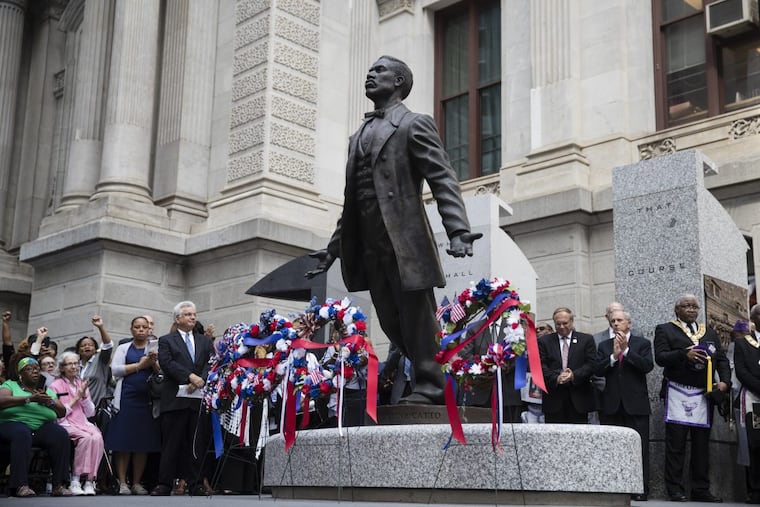Octavius V. Catto now a visible part of Philadelphia's history | Solomon Jones
Unveiling of new statue is a proud moment for the city of Philadelphia.

THE MAYOR AND another man tugged insistently at the edges of the bronze statue's black cloth covering, and at first, the cloth refused to move. Then Jim Kenney pulled harder, and the covering tumbled away, revealing the upturned face of Octavius V. Catto, the black man who will now be memorialized at the center of the city he changed.
It is ironic that Kenney was the one to uncover Catto's bronze visage on a sunny September morning. In doing so, Kenney and a diverse group of determined people took the last step in the yearslong journey to move Catto from the shadows of history to the light of day.
But for me, it is not the light so much as the contrast that matters. Catto and Kenney — Republican and Democrat, black and white, Protestant and Catholic — tell the story of who we are. They tell us that change is possible, that moving forward is inevitable, and that memorializing our best is honorable. More than anything, these two men, born more than a century apart, magnify the importance of symbols.
Often, without symbols, we never hear the substance of stories. And in Octavius V. Catto's case, the tale is nothing short of incredible.
"Catto was around 16 years old when he started to speak up," said Dr. V. Chapman Smith, a regional administrator with the National Archives and a board member of the Catto Memorial Fund, which raised money for the memorial. Speaking at the unveiling of Catto's statue, Chapman-Smith added that, "\[Catto\] and his family arrived in Philadelphia in 1848 to a dynamic and politically active free black community that had already built many institutions."
Catto became a valued member of that community, refusing to wait for the freedoms that should have come with American citizenship. Instead, he fought for them in every possible way. He fought by using his brain in the classroom, where he was educated and later became principal at the Institute for Colored Youth — the precursor to Cheyney University. He fought by using his talent on the playing field, founding a professional baseball team called the Pythians and playing shortstop and second base. He fought by using his courage on the battlefield, becoming an officer in the Union Army.
In Catto, Mayor Kenney said just moments before unveiling the statue and memorial, we find "the story of a courageous, unsung, young American military hero — who like countless other unknown and seldom recognized black Americans — contributed so much to make America great …"
"A major in the Army during the Civil War, an intellectual, an educator, athlete, civil rights activist who desegregated trolley cars in Philadelphia in the mid-1860s — and a good neighbor who walked the streets of our great city, Catto is a legendary American figure whose young life and tremendous accomplishments were cut short."
And that is where the stories of Octavius Catto and Jim Kenney intersect.
In the wake of the Civil War, when African Americans were fighting to be recognized as human beings worthy of equal citizenship, Catto worked to secure passage of the 15th Amendment to the U.S. Constitution, which gave black men, who mainly supported Abraham Lincoln's Republican party, the right to vote. But Catto didn't stop there. He also worked to get blacks to the polls.
That's what he was doing on Oct. 10, 1871, when he was confronted by Frank Kelly, an Irish Catholic immigrant who was aligned with Democratic party boss William McMullen. The Irish, who were initially unwelcome by many in America, had found that machine politics was a means to gain resources, and many in the Democratic Party were unwilling to share those resources with blacks.
So Kelly — reportedly with police nearby — killed Catto. An all white jury acquitted him years later.
Kenney, upon learning of Catto's story in the early 2000s, was moved to do something.
"I can't make it right," Kenney told me in an interview. "But I think people need to know that people like Catto lived and what they did and hopefully we can help bring some healing to the world."
Bemoaning the hate coming out of the White House, Kenney told me he was pleased to see people of all stripes at the unveiling of the Catto memorial. I was, too.
The symbolism of an Irish Catholic Democrat memorializing a black Protestant Republican speaks volumes about how far we've come — and how far we have to go.
Still, there are more issues — like the statue of brutal former mayor and police commissioner Frank Rizzo being removed from public property.
Kenney, who told me he was not a fan of Rizzo, said the process of deciding what to do with that statue is ongoing.
But in my view, if Kenney and Catto can meet more than a century apart at the intersection of race and class, economics and politics, substance and symbol, then anything is possible, including removing Rizzo's statue.